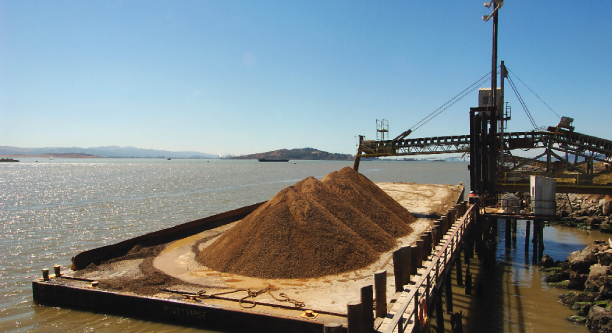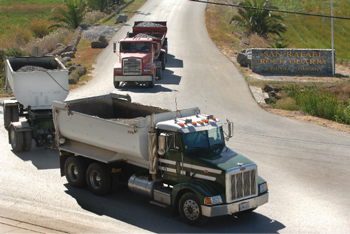The San Rafael Rock Quarry is one of those places most in Marin know little about, while a few know everything about it. Located on an elbow of land jutting into San Pablo Bay, the quarry is a passing curiosity for hikers headed to China Camp State Park or golfers bound for the Peacock Gap Country Club. It’s nearly invisible from Point San Pedro Road save for its proximity to the towering smokestacks of the adjacent McNear Brickyard.
Still, those who live in Peacock Gap and neighboring communities are all too aware of the quarry. They know the rumble of rock-laden big rigs; the thump of explosives turning big rocks into little ones; and the dusty grit in the air. They also know how to take the quarry to court in an effort to reconcile two disparate parts of Marin: the tranquil suburban life they envisioned, and an important industrial business that existed long before the first neighboring home .
For these neighbors, the quarry amounts to a noisy nightmare in their midst. “Their 18-wheeler trucks rumble by within 20 feet of our bedroom. It’s like we’re living on the 880 freeway,” says Dr. Denise Lucy, a business professor at Dominican University and co-president of the Point San Pedro Road Coalition, a neighborhood group formed to keep the quarry’s operations in check. “And when they’re blasting, people in houses across from the quarry say it feels like an earthquake.”
For the owner, the Dutra Group, the quarry is a successful business that employs more than 175 people full time and uses much of the 1.5 million tons of rock it excavates each year to keep California’s delicate water system intact. “Right now we’re involved in rebuilding the Sacramento Delta’s levee system,” says Bill Dutra, chief executive of the 103-year-old company and grandson of its founder. “If those levees ever fail, the state’s water supply would be endangered, thousands of lives could be lost, and we’re talking about $40 billion in economic damages.”It’s the classic quandary of people vs. industry. Factor in that the communities are in one jurisdiction (the City of San Rafael) and the quarry is in another (the County of Marin), and the quandary looks more like a quagmire.
The Quarry
To find the quarry, head out of San Rafael past Trader Joe’s on Third Street until it becomes Point San Pedro Road, which continues east to the Loch Lomond Marina, Peacock Gap and China Camp—all are neighbors. The 272-acre waterfront quarry, however, was there first. Bestowed with rich deposits of clay and shale, the area was a viable brickyard as far back as 1870. When hard-rock quarrying began in 1929, hardly a soul lived nearby.
After World War II, with the property ambivalently zoned “heavy industrial/limited agricultural” and Marin County beginning to burgeon, the neighborhood began to fill with homes and people. With them came discord. It was also a period when decisions regarding the quarry’s operations were less than well defined. A he said/we did/they said/I did culture is the lasting result.
 Wrangling over the quarry began in 1972 and continues today as a maelstrom of governmental acronyms, conflicting reports and overlapping dates. The county issued mining permits; the quarry indicated it would shut down by 1993; county supervisors rezoned the property to be compatible with surrounding areas; and real estate developers, lusting after the bayside land, began getting their building plans approved. Further complicating matters, the quarry was bought and sold several times during all the giving and taking.
Wrangling over the quarry began in 1972 and continues today as a maelstrom of governmental acronyms, conflicting reports and overlapping dates. The county issued mining permits; the quarry indicated it would shut down by 1993; county supervisors rezoned the property to be compatible with surrounding areas; and real estate developers, lusting after the bayside land, began getting their building plans approved. Further complicating matters, the quarry was bought and sold several times during all the giving and taking.
Bill Dutra, an up-by-the-bootstraps entrepreneur, purchased the quarry in 1986. He saw a lucrative opportunity where others saw the proverbial (and literal) rock and a hard place. More than 20 years later, it’s reasonable to say he has taken the quarry’s operations to a higher—and, say neighbors, a noisier and dustier—level.
The San Rafael Rock Quarry is one of only two such waterfront operations in California (the other is on Southern California’s Catalina Island). Having bay frontage means eight-ton boulders, riprap and gravel can be placed directly on barges, then guided by tugboat to destinations like Pacifica and the Delta. An equal amount of the quarry’s product leaves on trucks that make their way down Point San Pedro Road to job sites throughout Marin and Sonoma counties.
The geographic highlight and physical low point of the quarry is the Main Quarry Bowl, aka the “pit,” a jagged, benched gash in the earth that, measuring west to east, is six football fields wide and drops from 250 feet above sea level to an equal distance below. At the bottom, visible over a precipitous edge, is a 50-foot-deep basin of rainwater. Current mining is centered on South Hill, where, says General Manager Steve Long, “there’s between 15 to 20 years of Franciscan sandstone yet to be mined.”
To a visitor, the scene inside the quarry borders on the surreal. A spidery maze of conveyor belts and sorters moves tons of rock from ground to truck. Huge yellow front-loaders with scoops the size of cars and biodiesel-powered dump trucks with monster wheels zip with surprising agility between towering cones of material. Rising from what appears to be piles of rubble everywhere, but is in fact part of the $90 million in product generated at the quarry each year, are an asphalt batching plant, two crushing plants and three loading docks for the barges. To tour the quarry is to receive a firsthand look at how the industrial age works.
The Community
Within a mile and a half of this scene, in addition to Peacock Gap, are the well-coiffed neighborhoods of Loch Lomond, Glenwood, Marina Bay Park and the recently completed 18-home Chapel Cove. All but Chapel Cove were established before 1986, when Dutra bought the quarry. So why were they ever permitted, with an existing quarry nearby? In 1982, San Rafael adopted the Peacock Gap Neighborhood Plan, wherein an owner previous to Dutra indicated mining operations would most likely be curtailed “within ten years.”
Opposition to the quarry was formalized eight years ago with the formation of the Point San Pedro Road Coalition, Dr. Lucy says. The group has 400 members, a dozen committees, and a five-member board of directors that meets regularly. “We hold community-wide meetings twice a year,” Lucy adds.
The neighbors’ complaints focus on truck traffic, dust, explosive blasting said to be heard as much a mile and a half into the neighborhoods, and night lighting and noise from barge-loading operations. “Differing communities are impacted in different ways,” Lucy says.
The Lawsuit
In 2000, the San Pedro Road Coalition, Marin County and the state attorney general’s office sued the Dutra Group. In 2004, Superior Court Judge John Sutro issued a decision that cited Dutra for expanding his operations without proper permits, blamed Marin County for a lack of oversight and imposed limitations on quarry operations hoping to give homeowners some relief. Effectively, he closed the quarry, but stayed the order pending an environmental review and twice-a-year status hearings to ascertain whether the quarry was making a good-faith effort to comply with his order.
Sutro’s order imposed numerous limitations on quarry operations. Among them:
- No more than 250 big rig trips per weekday; none on weekends.
- Rock crushing and/or barge loading only between 7 a.m. and 10 p.m. weekdays; none on weekends.
- Blasting only between 11:30 a.m. and 1:30 p.m. weekdays, with 36 hours’ advance notice posted on the quarry’s website; no blasting on weekends.
Since then Dutra has, either voluntarily or at the coalition’s behest, installed a metering light to stagger the entry of big rigs onto Point San Pedro Road, placed tarps on trucks, improved the mechanism that removes dust and debris from trucks leaving the quarry, quieted backup beepers on haulers and loaders, bought a new street sweeper that cleans Point San Pedro Road twice a day, and initiated a “truck marshal” service to ensure independent truckers are watching their speed and staying in the right-hand lane.
The Future
The relationship between the quarry and the community took a turn for the worse in 2006. That spring, on the heels of flooding in northern Marin County and the Hurricane Katrina levee collapses in New Orleans, Gov. Arnold Schwarzenegger ordered the emergency repair of 29 levees in the Sacramento–San Joaquin Delta, including some whose collapse would endanger the state’s water supply.
The San Rafael Rock Quarry got the job and, without seeking county permission, ramped up its operations in July 2006. (“The public is my customer,” Dutra reportedly said at the time. “What they need, I do.”) The company sought retroactive permission from the Board of Supervisors for round-the-clock operations, saying it needed the extra hours to meet its state deadline for levee repair, but the board rejected the request and the matter landed back in Judge Sutro’s lap.
At a hearing in January of this year, the judge said he had received 200 complaints from 70 residents. “I suggest to the quarry that before something is rammed down your throat that you don’t like, you ought to listen to these people,” he warned Dutra’s attorney. A court-ordered closing of the quarry seemed a distinct possibility. That would suit Supervisor Susan Adams, who represents the area. “They’ve definitely been out of compliance with both the court order and the zoning,” she maintains.
 Bill Dutra sees things differently. Because the quarry existed before the surrounding homes, he asserts in an interview, his “vested rights” preclude those of his neighbors. Also, the quarry is a “state-designated resource” because of its importance to public safety. Much of the work he does is for “schools, parks and roads right here in Marin County,” he adds.
Bill Dutra sees things differently. Because the quarry existed before the surrounding homes, he asserts in an interview, his “vested rights” preclude those of his neighbors. Also, the quarry is a “state-designated resource” because of its importance to public safety. Much of the work he does is for “schools, parks and roads right here in Marin County,” he adds.
The next step in the saga is the completion of two environmental impact reports due in mid-to late 2008, Adams says. “One concerns the county’s amended mining permit that will formally reduce the quarry’s impact on its neighbors,” she says. The other “relates to what Mr. Dutra will do with his property once the quarry operation is no longer profitable.”
The current post-mining plan calls for blasting out the north side of the quarry’s pit and allowing it to flood with water from San Pablo Bay. A 600-slip marina would occupy the newly formed lagoon, which would be surrounded by 350 homes, plus office and retail space. At which point Dutra and his neighbors might see eye to eye on one thing: Think of the traffic on Point San Pedro Road then.


